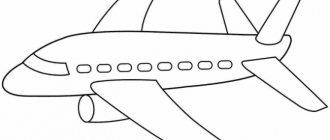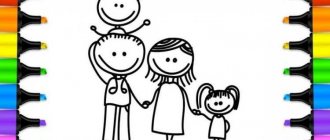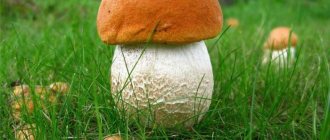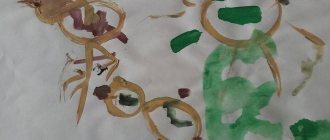Lesson notes. Drawing on the theme “Different buildings on the street”
Detsky sad.Ru >> Electronic library >> Family and children >> Children's creativity >> Sakulina N. P. and Komarova T. S. “Art activities in kindergarten” (Manual for teachers).
M., “Enlightenment”, 1973 OCR Detskiysad.Ru Abbreviated. Program content.
Learn to depict in a drawing various buildings of a city or village located nearby on one side of the street. Expand your understanding of various rectangular shapes - wide and narrow, high and low. Develop technical techniques for drawing with a pencil: hold the pencil about 5-6 cm away from the end, do not squeeze it tightly with your fingers, do not bend your index finger. Practice the ability to draw lines smoothly, easily, continuously, paint with uniform movements back and forth in one direction; change the direction in accordance with the shape of this part of the pattern, do not rush, do not swing, do not press hard. Choose colors beautifully when painting buildings, use light colors first for painting walls. Methodology of conducting the lesson. The teacher tells the children that they will draw different houses on the street. He asks to remember that they saw taller and shorter houses, wide and narrow. There are houses that house a nursery, a kindergarten, a dining room, a cinema, a store, etc. They live in many houses. Remind the children how to hold a pencil and how to draw: first, several houses of different heights and widths (only walls and roofs), and then draw windows and other details. The houses should not be located at the very edge of the sheet, but retreating a little so that there is room for the street. At the end of the lesson, look at the drawings and discuss with the children whether the houses are similar to those in a given city (town, village), in which house there is a cinema, department store, school, etc. Bring the children to understand that buildings for different purposes are different from each other, they look different. Preparing for the lesson. Take a tour. Pre-select a place from where children can see several buildings of different sizes and purposes. Let the children speak about what they see. Clarify the difference in the height and width of houses, note the different purposes of buildings and associated characteristic features. Place illustrations in the corner of the book showing urban or rural houses of different heights and purposes. Prepare paper the size of a writing sheet and simple graphite pencils. Note. Remind children not to crosshatch anything with a graphite pencil; in their free time, give their drawings to those who wish to color them in with colored pencils. Show how to make light movements to get a light color on the walls and roofs of houses. After coloring, children can add anything to their drawing if they wish. continuation …
Summary of a lesson on artistic creativity - drawing in the 1st junior group "Let's decorate our houses"
Goals:
- Continue to arouse children's interest in drawing.
- Introduce children to the technique of decorating previously created images of houses with strokes, dots, and circles.
- Reinforce the rules for washing your brush after painting with paint.
- Encourage children to use 2 different colors of paint.
- Fix the names in yellow and green.
- Instill in children a feeling of joy from the work done.
Preliminary work: drawing snow on sheets of paper with images of houses drawn with colored chalk; building houses for small toys; making the application “Beautiful Houses” from ready-made geometric shapes; examination of illustrations by Yu. Vasnetsov, which depict houses with decorative decorations. Integration of areas: cognition, artistic creativity, labor, health, safety, socialization, communication. Benefits: book “Russian folk tales”, subject pictures - frog, mouse, fox, wolf, bear; easel; glued houses made of colored paper; yellow and green gouache, brushes, cotton swabs, glasses of water, rags for each child. Progress of the lesson. The teacher calls the children over and begins to talk with them about fairy tales. In the hands of "Russian folk tales". — Guys, what kind of fairy tale do you think is hidden in this book? (Teremok). - How did you guess? (According to the cover). - And who lives in this fairy tale? (children's answers). - Yes! These are the little mouse, the frog, the runaway bunny, the sister fox, the wolf-gray tail and the clubfoot bear. - Look, here they are - the inhabitants of the tower (The teacher draws the children’s attention to the easel with animals). - Guys, what did the bear do in this fairy tale? (Children's answers).
- Yes, the bear broke their house. - why did he break it? (Because the bear was big and heavy!) Poor animals. -Where should they live now? After all, they need a house! - Guys, remember, you and I have already made houses for our animals. - Remember how you made them? (Glued). - What do you think needs to be done to make these houses even more beautiful and appeal to our forest animals? (Color with paints.) - Do you want to color them? (Yes). - Katyusha, who would you like to decorate the house for? (For…). Here, take yourself a fox. And you, Masha, who would you like to decorate the house for? Here's a runaway bunny for you. And Kira got a clumsy bear. (Each child gets one animal). Then sit down at the tables. Place your animals nearby. They will watch you decorate the house for them! - Let’s start by flexing our fingers so that they can make the houses very beautiful. Finger gymnastics.
| Saw, drank, drank faster. We are building a house for animals. Knock, knock, I knock. I'll put together a new house. We'll paint this house. The animals will live in it. | The right hand is placed on the rib and done. movements back and forth. They made fists and put them on one by one. on top of each other. Swing both hands up and down, It's like they're painting it. |
- Well, our fingers have warmed up, warmed up and now we can start decorating the houses. — There are houses in front of you. Look, what else do you have on your tables? (Paint, brushes, cotton swabs, water, ...) - Sit up straight, legs straight, sleeves raised so as not to stain them. — Take the brushes correctly in your hands, by the piece of iron, with two fingers, or with cotton fingers. Dip it in water, then in the paint of your choice. We already know how to use both cotton swabs and brushes. - You already know how to draw circles and dots! Now we will paint with strokes and spots. (Show to children). (Familiarity with the rules of washing the brush after painting with paint of one color in order to use another.) Fixing the names of paint colors. Individual assistance. Watch the planting.) - What beautiful houses you make! “And the fox and the wolf, and the bunny and the mouse, and the bear and the frog will really like the houses!” Analysis of children's works using game characters.
Summary of an open drawing lesson in the junior group “House for the Dog”
Apostolova Liliya Sagitovna
Summary of an open drawing lesson in the junior group “House for the Dog”
Summary of an open lesson on artistic and aesthetic development in the junior group on the topic “ House for the Dog ”
.
Goal: - teach children to draw houses , conveying the rectangular shape of the walls and the triangular shape of the roof;
- develop the ability to supplement the image with elements based on impressions of the surrounding life;
- cultivate a desire to help others, a sense of compassion.
Materials: presentation of houses, paints, brushes, jars of water, napkins, toy puppy.
On the topic: methodological developments, presentations and notes
Develop artistic imagination and aesthetic taste.
Use of various types of visual activities in the classroom.
This lesson is aimed at consolidating knowledge about geometric shapes - circle, square, triangle, as well as consolidating knowledge about animals.
This lesson is aimed at consolidating knowledge about geometric shapes - circle, square, triangle, as well as consolidating knowledge about animals.
Objectives: Strengthen children’s ability to draw geometric shapes: square, triangle, circle. Convey the relative size of parts of an object. Strengthen knowledge about the main parts of a building (d.
TOPIC: “House for a dog” Age group: senior group (5 – 6 years old) Developer: Chekanova M.M., Form of organizing children’s activities: subgroup. Educational and methodological set: Adapt.
Goal: Improve children’s ability to arrange parts in a certain sequence. Objectives: Educational: expand the knowledge of children and animals; fix the names of geometric shapes: circle, .
Source





